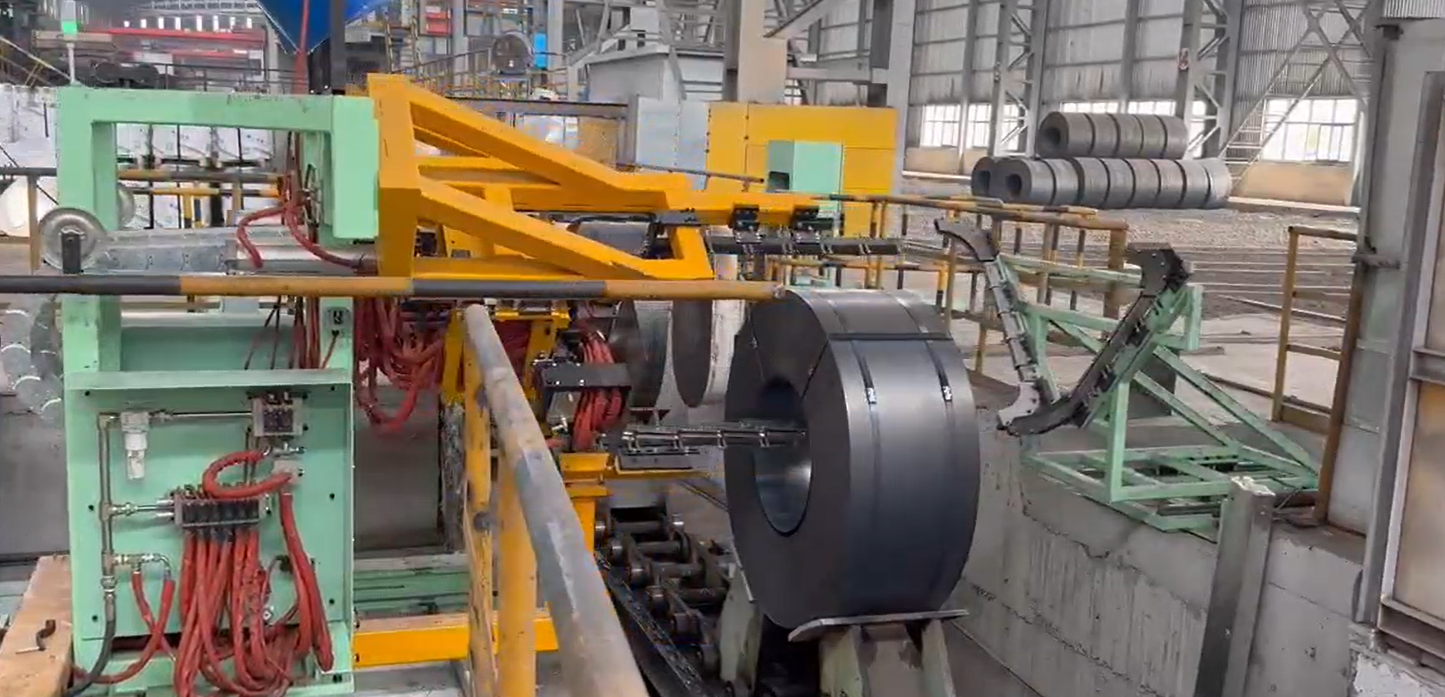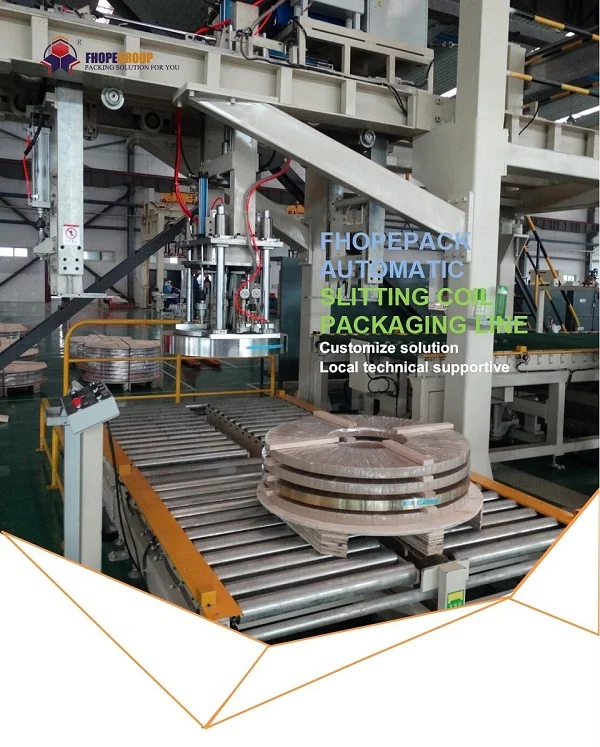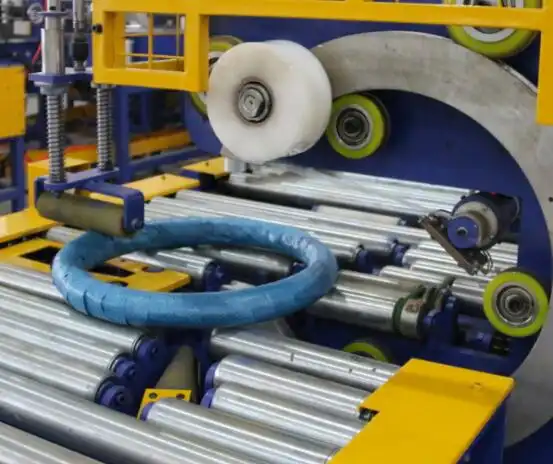Rising energy prices in Canada are a constant pressure on your bottom line. Every day, your aging equipment consumes more power than it should, silently chipping away at your profits. You might feel like these operational costs are just a fixed part of doing business, a number on a spreadsheet you can't control. But what if the end of your production line could become a new source of significant savings? An energy-efficient coil packing line isn't just a machine; it's a strategic tool designed to cut your power consumption, reduce material waste, and lower your overall operating costs.
The most direct way to cut packaging costs in Canada is to upgrade to a modern, energy-efficient coil packing line. These systems are engineered with high-efficiency motors, intelligent power-saving controls, and optimized mechanical designs. Together, these features dramatically reduce electricity use per coil, minimize the need for costly maintenance, and cut down on consumable material waste. This leads to substantial and predictable long-term financial savings for your plant.

This isn't just about a smaller electricity bill. The real value goes much deeper, impacting your labor costs, material usage, and even your plant's total output. I've seen it happen time and again. An investment in the end of your line can transform the efficiency of the entire operation. Let's break down exactly how these systems deliver real-world savings and what that means for your Canadian facility's bottom line.
How Do Modern Coil Packing Lines Actually Reduce Energy Consumption?
You read the words "energy-efficient" on every brochure, but what does that truly mean for a heavy-duty machine on your factory floor? It's easy to dismiss it as a marketing buzzword, especially when you need to justify a significant capital investment. You are right to be skeptical. You need to understand the specific engineering behind the savings to believe in the results.
Modern coil packing lines reduce energy consumption through a combination of three critical technologies. First, they use high-efficiency motors controlled by Variable Frequency Drives (VFDs) that consume far less power. Second, their intelligent control systems use sensors to activate sleep or standby modes, ensuring energy is only used when the machine is actively working. Third, their mechanical design is optimized to minimize friction and wasted motion, requiring less energy to perform each task.

Deeper Dive: The Mechanics of Energy Savings
Let’s break down the technical aspects. It's in these details where you find the real, measurable cost reductions. The difference between an old machine and a new one isn't just age; it's a completely different philosophy of design.
The Power of Variable Frequency Drives (VFDs)
An older packing line likely uses motors that are either fully on or fully off. When a conveyor needs to move a coil, its motor slams to full speed, drawing a huge amount of electrical current. It's like flooring the gas pedal in your car every time you move an inch. A modern line uses VFDs. A VFD acts like a smart gas pedal for the motor. It gradually ramps the motor's speed up and down, using only the precise amount of energy needed for the task. For operations with frequent starts and stops—like moving coils on and off the line—this single technology can reduce that motor's energy consumption by 20% to 50%. It also reduces the mechanical shock on the drive train, which means less wear and tear and fewer maintenance-related downtimes.
Intelligent Automation and Standby Modes
Your packing line isn't wrapping a coil 100% of the time. There are gaps between coils. On an old machine, the motors, hydraulics, and control panels often keep running, burning electricity for no reason. A modern line, managed by a PLC (Programmable Logic Controller), is smarter. It uses sensors to know exactly when a coil is entering, when it's being wrapped, and when the line is empty. During those idle moments, it can automatically enter a low-power standby mode, shutting down non-essential components. It wakes up instantly when the next coil approaches. This feature alone eliminates a significant source of "vampire" energy waste that accumulates over every shift.
Optimized Mechanical Design
Finally, efficiency comes from smart physics. I've seen old machines with heavy, oversized components that create enormous friction and inertia. They need massive motors just to get moving. Today, we use engineering software to design components that are both strong and lightweight. The wrapping ring, for example, can be built from lighter materials without sacrificing strength. We use better bearings and more efficient gearboxes. Every bit of friction we eliminate means less energy is needed to power the machine. It’s a cumulative effect; small efficiencies in many different places add up to a large overall reduction in power consumption.
| Feature | Old Packing Line | Energy-Efficient Line | Impact on Canadian Operations |
|---|---|---|---|
| Motor Control | Fixed Speed / Direct On-Line | Variable Frequency Drive (VFD) | Reduces peak demand charges on utility bills; cuts motor energy use by 20-50%. |
| Idle State | Runs Continuously | Smart Standby / Sleep Modes | Eliminates wasted energy between coils, lowering the baseline power consumption. |
| Mechanical Design | Heavy, high-friction parts | Optimized, low-friction components | Less wear means lower maintenance costs and less power draw to overcome friction. |
| Hydraulic System | Often runs constantly | On-demand hydraulic pump | The pump only runs when pressure is needed, drastically cutting energy waste. |
What Specific Features Lower Operating Costs in a Canadian Context?
You're running a facility in Canada. That means you face a unique set of challenges and costs. Labor is highly skilled and rightly expensive. The climate can be unforgiving, with cold winters impacting both machinery and logistics. A solution that works perfectly in a milder climate might fail or become inefficient in a Canadian warehouse. You are right to worry about hidden operational costs that are specific to your region.
For Canadian steel and wire facilities, the most impactful cost-saving features are intelligent automation that minimizes manual labor, durable construction designed to perform in cold temperatures, and systems optimized to reduce the consumption of expensive packing materials. These features directly address the highest variable costs in a Canadian operational environment, which are labor, maintenance, and consumables.

Deeper Dive: Tailoring the Solution for Canada
A packing line isn't a one-size-fits-all product. A strategic supplier understands the local context. For Canada, we focus on three areas that deliver the biggest impact on your operating budget.
1. Radically Reducing Labor Dependency
In my experience, automation in the packing area provides one of the fastest and most significant returns on investment, especially in a high-wage economy like Canada's. Your most valuable assets are your skilled people. Are they spending their time on low-value, repetitive tasks like manually feeding straps, applying labels, or moving wrapped coils? A modern packing line can automate all of it. Automatic strapping machines, integrated print-and-apply labelers, and robotic palletizers can transform your packing station from a manual process into a supervised, automated system. I worked with a client in Ontario whose team was spending hours each shift manually strapping slit coils. After we installed an automated line, he was able to reassign two of his most experienced workers from that repetitive task to the quality control department, where their expertise could add far more value to the business. The machine paid for itself not just in labor hours saved, but in improved product quality.
2. Slashing Consumable Material Costs
Stretch film and strapping are not cheap, and their prices can be volatile. An old or poorly maintained wrapper wastes these materials. A modern wrapping machine with a powered pre-stretch system can make a huge difference. These systems can stretch the film by 200-300% before it's applied to the coil. This means one meter of film from the roll becomes three or four meters on the product. It creates a stronger, more secure wrap while using significantly less material. A precise, automated system also ensures consistent application, eliminating the waste that comes from operators applying too much film "just to be safe." A 25% reduction in film consumption for a plant producing two million tons a year translates into massive annual savings.
3. Engineering for Durability in a Cold Climate
A machine that runs well in May needs to run just as well in January. The cold Canadian winter can be tough on machinery. Hydraulic fluids can thicken, metal can become brittle, and condensation can affect electronics. A packing line designed for the Canadian market must be built to withstand this. This means using components rated for low temperatures, specifying the correct lubricants, and ensuring all electronics are housed in properly sealed enclosures (e.g., NEMA-rated). This focus on robust engineering isn't a luxury; it's essential for maintaining uptime. A breakdown due to cold weather isn't just a repair bill; it's a production halt that can cost you thousands per hour.
| Cost Factor | Challenge in Canada | Modern Line Solution | Financial Impact |
|---|---|---|---|
| Labor | High wages and skill shortages. | Full automation of strapping, wrapping, labeling, and handling. | Reduces direct labor costs; frees up skilled staff for higher-value roles. |
| Materials | Volatile prices for stretch film and steel/PET straps. | Powered pre-stretch systems (200-300%); precise, automated application. | Cuts consumable material costs by 15-30% or more annually. |
| Climate | Cold winters impacting machine performance and reliability. | Robust build, low-temperature rated components, sealed electronics. | Increases uptime, prevents costly winter-related breakdowns and maintenance. |
How Does an Upgrade Improve More Than Just Your Energy Bill?
You are rightly focused on cost reduction, but you also know that your plant's long-term success depends on more than just saving money. You've likely experienced the frustration of an unexpected breakdown on an old machine. That one failure can cause a chain reaction, halting production, delaying shipments, and damaging relationships with customers. You feel stuck in a constant cycle of putting out fires instead of focusing on growth.
A modern coil packing line upgrade is a catalyst for wider operational excellence. It immediately boosts throughput by eliminating bottlenecks and drastically improves plant safety with integrated modern guarding and sensors. Most importantly, it generates valuable production data, enabling a shift from reactive repairs to predictive maintenance. This directly addresses the core goal of maximizing uptime and overall equipment effectiveness (OEE).

Deeper Dive: Unlocking Hidden Operational Value
The "soft" benefits of a new packing line often have a harder, more profound impact on your business than the direct cost savings. Let's look beyond the utility bill.
A Quantum Leap in Throughput and Uptime
For many steel and wire plants I've visited, the packing line is the single biggest bottleneck. You can have the fastest production mills in the world, but if you can't pack and ship the product quickly enough, your overall capacity is limited by your slowest machine. An old, semi-automatic line might process 15 coils per hour. A new, fully automated line can often handle 30, 40, or even more. This isn't just about speed; it's about reliability. New machines, built with better components and fewer wear parts, have a much higher Mean Time Between Failures (MTBF). By removing this bottleneck and increasing reliability, you unlock the true production potential of your entire facility. This is how you reach your goal of 95% asset uptime.
A Safer Workplace and Simpler Compliance
Safety is not an option. An older machine may not meet current Canadian safety standards, such as those from the CSA Group. Retrofitting old equipment with modern safety features can be expensive and complex. A new machine is designed with safety as a core principle. It comes with integrated light curtains, physical guarding, emergency stop circuits, and access-controlled gates. This drastically reduces the risk of workplace accidents. The benefits are clear: you protect your people, which is always the first priority. You also reduce the risk of costly shutdowns, investigations, and potential increases in your WCB premiums. A safer workplace is a more productive and positive workplace.
Your Gateway to Digital Transformation (Industry 4.0)
If you have goals for digitalization, your packing line is a perfect place to start. Unlike old "dumb" machines, a modern line is packed with sensors. It knows how many coils it has wrapped, the cycle time for each one, the amount of film and strap used, and it logs any error or fault codes. This is incredibly valuable data. We can connect the machine's PLC directly to your plant's Manufacturing Execution System (MES) or ERP system. You can see real-time performance on a dashboard in your office. Your maintenance team can get alerts before a failure occurs. This is the foundation of predictive maintenance and the "smart factory." You stop reacting to problems and start proactively managing your assets based on real data.
| Benefit | Old System Limitation | New System Advantage | Strategic Value for Your Plant |
|---|---|---|---|
| Throughput | Slow cycle times, frequent jams, acts as a bottleneck. | Faster, more reliable, and consistent cycle times. | Unlocks full plant production capacity, increases revenue potential. |
| Safety | Outdated or missing safety features, high risk of accidents. | Meets current CSA standards; integrated light curtains, guarding. | Protects employees, reduces liability, lowers insurance costs. |
| Data & Control | No data collection; "black box" operation. | IoT-enabled sensors track KPIs; integrates with MES/ERP. | Enables data-driven decisions, predictive maintenance, and process optimization. |
My Insight: Why is Your Packing Line More Than Just an Expense?
Many factory owners I meet see their packing line as the last, least exciting step in their process. It's viewed as a necessary cost center, a piece of equipment you have to buy but don't really want to think about. Honestly, when I first started my journey in this industry, I had a similar mindset. But I learned the hard way that this thinking doesn't just cost you money; it costs you opportunity.
Your packing line is not an expense; it is a critical strategic asset. A reliable and efficient packing line does more than just wrap steel. It protects the quality of the product you worked so hard to make. It enhances your brand's reputation with every single shipment. And it unlocks the full production potential of your entire plant. Think of it as the final, firm handshake you give your customer before they receive their order.

Deeper Dive: A Lesson from My Own Factory Floor
When I made the transition from being an engineer to owning my own factory, capital was tight. I invested every dollar I could into the core production machines—the ones that made the product. For the packing station, I tried to save money by purchasing a second-hand, older wrapping machine. On paper, it looked like a smart, frugal decision. In reality, it quickly became my single biggest headache.
The machine was slow, and it couldn't keep up. Within weeks, it created a massive bottleneck that forced our entire production schedule to slow down. The wrapping itself was inconsistent. Sometimes it was too loose; other times it would damage the edges of the coils. Soon, the calls started coming in from angry customers. They sent pictures of coils that had arrived at their facilities damaged in transit because the packaging had failed. We were losing credibility.
Internally, it was a drain on morale. I had two of my best workers spending half their day just babying this old machine, manually fixing bad wraps, and dealing with constant jams. Their skills were being completely wasted on a problem that shouldn't have existed.
The turning point came when one of my biggest clients put us on notice. They were happy with our product quality, but they told me if we couldn't fix our packaging and delivery issues, they would have to find another supplier. That's when the lesson hit me with full force. The packing line isn't the end of your process. It is the beginning of your customer's experience with your product. A damaged coil isn't just a quality claim; it is a broken promise. It tells your customer that you don't care about the final details.
I took out a loan and invested in a new, fully automated packing line. The return on investment wasn't just in the energy and material savings, though those were significant. The real ROI was in customer retention and trust. It was in the new, larger orders we could confidently accept because we knew we could ship them on time and in perfect condition. It was in freeing up my best people to focus on innovation and growth, not just on fixing problems. That machine didn't just wrap coils; it allowed my business to scale. This is the insight I am most passionate about sharing. Don't look at your packing line as a cost. See it as the machine that protects your quality, your reputation, and your future growth.
Conclusion
Investing in an energy-efficient coil packing line is a powerful strategic move. It directly cuts your Canadian operating costs, boosts plant uptime, and strengthens your brand with every coil you ship.




